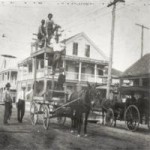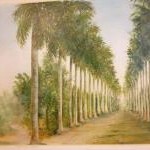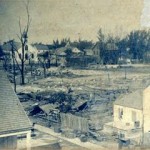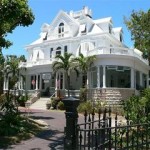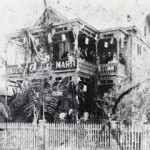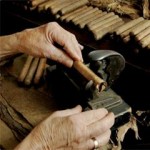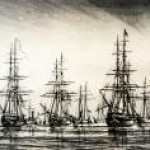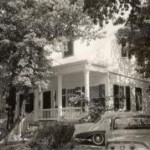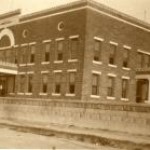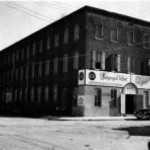Come experience 120 Historic Markers in the Largest Historic District of Frame Buildings in the United States. See photos and listen to the history and stories these buildings have to tell. Take a self-guided tour and discover a little piece of paradise.
Check Out Our YouTube Videos
Key West Electric Company
Power first came to Keys West in 1887 when J.J Philbrick created the Key West Gas and Electric Light Company. A decade later, Curry and Sons started their own power plant. Eventually, these competing companies combined and were purchased by Stone and Webster in 1906. In 1943, the City acquired the company, creating City Electric System that provided power with diesel and steam generators and imported power from the mainland over a 150-mile tieline. City Electric System continues today as Keys Energy Services.
The Freeman-Curry House
Built of heart pine by shipbuilder and merchant Samuel Filer. In 1920, the structure was moved back forty feet to its present location. The double parlor features wall murals painted in 1925. The house has been sold only once, in 1920, to the Freeman-Curry family. During the last century, the family became best known as political leaders with six members elected to local, county and state positions. The Monroe County Court House is named the Freeman Justice Center in their honor.
1886 Fire
At 2:00 a.m. on April 1, 1886 Key West’s most devastating fire was ignited very symbolically next to the San Carlos Institute, our focal point of Cuban society. The fire decimated the downtown area, burning down 16 major cigar factories, 200+ houses and government warehouses. The blaze is believed to have been started by Spanish spies in an attempt to stop the funding and support Key West had for the Cuban revolutionaries vying for their independence from Spain.
The Curry Mansion
This is the site of two Curry homes. William Curry, Florida’s first millionaire, raised his eight children in the original house built in 1869. His son Milton built the current mansion in 1905 keeping the original kitchen from his father’s house. It is believed that Aunt Sally, William’s house cook, created the first key lime pie when Milton was a young boy. William’s children built seven majestic mansions around Key West in the years to come.
La Terraza de Marti
The home of cigar manufacturer Teodoro Perez will forever be a symbol of Key West’s strong ties to Cuba. On May 3, 1883 Teodoro welcomed Jose Marti, the man who was the symbol of Cuba’s bid for independence from Spain, to speak from his balcony to thousands of Cuban sympathizers. Marti is acclaimed as a national hero of the Cuban Revolution and was an integral factor in freeing Cuba from Spanish rule.
Cigar Capital of the World
At its peak in the 1890’s Key West had 200 cigar factories and 2085 cigar rollers producing one hundred million hand rolled cigars a year. A skilled cigar roller could roll 300 cigars a day or nearly ninety thousand cigars a year. The success of the cigar industry contributed to Key West being the largest and wealthiest city in the State of Florida from the Civil War until the turn of the 20th century.
The Mosquito Fleet
By the end of 1822, mere months after the first US flag was planted in Key West, Commodore David Porter was sent to take charge. Porter commanded the West Indian Squadron nicknamed the “Mosquito Fleetâ€. Porter was ordered to end the reign of “The Brethren of the Coast,†the original pirates of the Caribbean. With the help of the Sea Gull, the first steam powered ship in the US Navy, Porter’s efforts are credited with eliminating piracy in the Caribbean.
Benjamin Curry House
Built by Benjamin Curry Jr., the brother of Florida’s first millionaire. The property has remained in the family for well over a century. His grandson, Benjamin Curry Moreno was a city engineer responsible for developing Key West’s modern roads and sidewalks. His daughter Betty married Toby Bruce, a man brought to Key West by Ernest Hemingway. Toby was often referred to as Hemingway’s “man Friday†and remained friends with the Hemingways for decades. Toby was a pall bearer at Ernest’s funeral.
Bruce Hall
Built as part of a Methodist educational complex at Hargrove Seminary, Bruce Hall featured a 600 seat auditorium with a roof garden. It served as part of the United States Navy Hospital during World War I through World War II. After 40 years of providing educational and health services Hargrove Seminary was demolished with the exception of Bruce Hall. The hall began its next life as the Navy commissary and is currently part of the Monroe County school system.
Ferdinand Hirsch Cigar Factory
This is the third and largest cigar factory owned and operated by cigar manufacturer Ferdinand Hirsch. Hirsch originally came to Key West from New York and started producing cigars in 1892 during Key West’s cigar boom. Hirsch owned this factory for a mere four years before he died. After Hirsch passed away six other cigar manufacturers, including E.H. Gato, occupied his former factory, producing cigars that were considered to be the best in the world.
